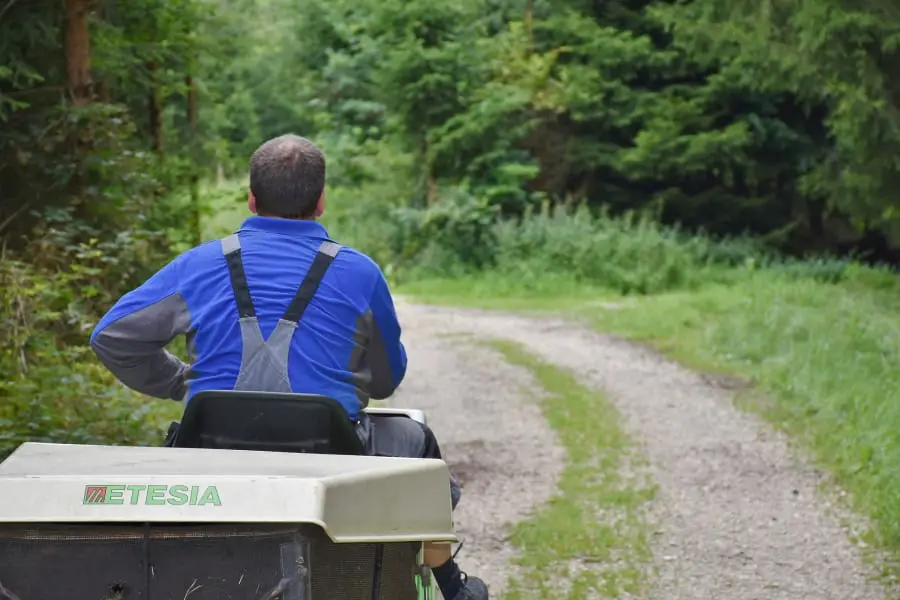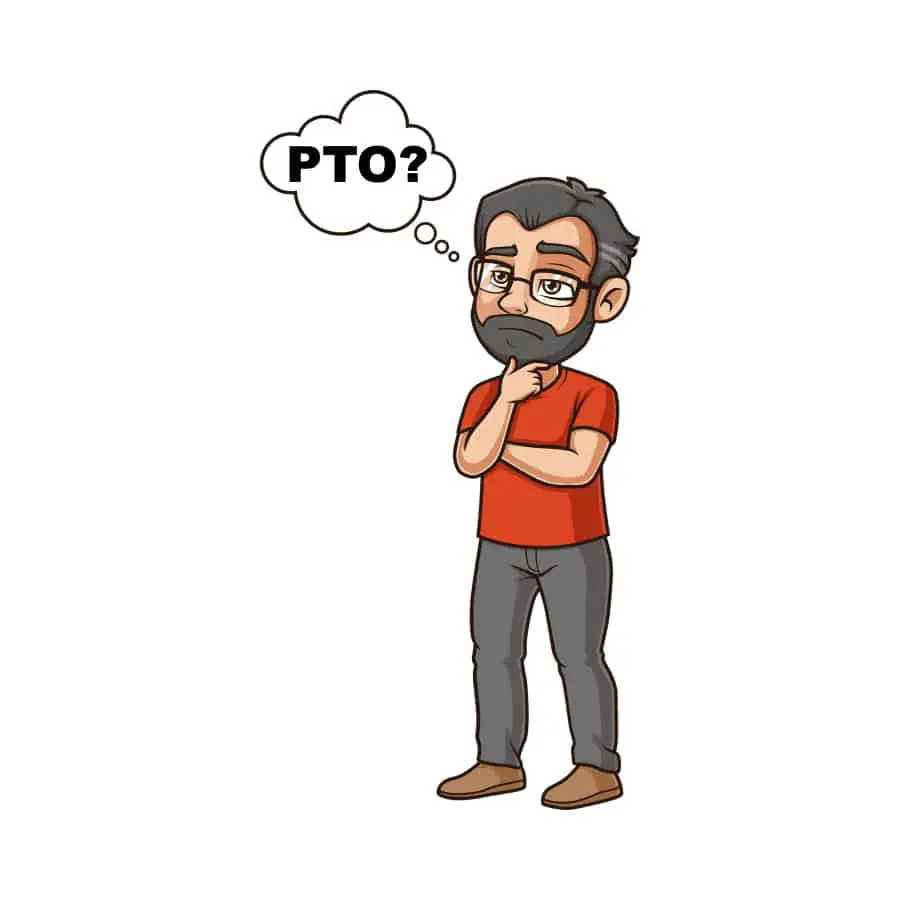“PTO” is one of those abbreviations that may fly over the heads of people who are new to the more technical side of lawnmower technology. What does it stand for? More importantly, how does it work? How do you know it’s working correctly?
The PTO system that connects the mower’s engine to the mower deck and blades is controlled by a switch, clutch, cable, flywheel, and brake. It is employed to allow blades to be spun or stopped according to the operators needs while the engine is still running.
Join me as I answer these questions, and more, in the following article. We will discuss the basics of how a lawnmower PTO works, as well as how to test its functionality. I will also highlight the longevity of a PTO system and how to tell when to get replacement components. Let’s begin!

Contents
What Is A PTO On A Lawn Mower?
A PTO, or “power take-off”, is a system of parts that help transfer power from a machine’s engine to any attached power implement. Does this mean where mowers are concerned that this power implement is the mowing deck and blades?
A lawnmower PTO system connects the mower or garden tractor’s engine to the implement (mower deck and blades in this case). It consists of a PTO clutch, a control switch, and an electrical cable that connects the two. It is used to turn on or off the spinning blade cutting action.
The main reasons that a PTO system exists is to allow safe operation of a mower without the spinning blades. This becomes not only safe, but extremely useful in many situations.
Hera are some other articles I recommend if you like this subject…
- How To Bypass A Safety Switch On A Snapper Mower
- What Are Lawn Mower Blades Made Of?
- Why Can I Only Run My Mower With The Choke On?
How Does A PTO Work On A Lawnmower?
This function is great because it allows the operator to stop the blades while keeping the engine running. As a result, the operator can empty mulching bags or tend to other tasks without the hassle of having to restart the lawnmower every time. It also eliminates the risk of the unattended mower scalping your lawn!
The mower or garden tractor operator activates the PTO switch (or lever in some cases) to engage the mower deck and spin the blades. To get the blades to stop spinning, the operator simply deactivates the switch. This allows operation of the drive system with or without the cutting function.
The PTO clutch system consists of an upper and lower plate. The upper plate sits directly below the engine’s drive pulley and it houses a large electromagnet on the inside. The lower plate is a flat metal disc that has a large mower deck pulley attached to the bottom.
Sandwiched between the two plates is a rotor, or “flywheel”, that is driven by a shaft that goes through the upper plate and connects to the drive pulley. When the engine is running, the drive pulley spins this shaft, which spins the flywheel. The flywheel’s face is dotted with holes and gaps to allow the magnet on the upper plate to interact with the lower plate.
When the operator activates the PTO switch, an electrical signal travels down from the switch to the upper plate and activates the magnet. When this happens, the lower plate gets attracted upwards and latches on to the spinning flywheel. This is possible because the magnetic force can travel through the gaps on the flywheel.
Once attached to the flywheel the lower plate and, ultimately, the mower deck pulley also begin rotating. This causes the mower’s blades to spin.
Note that the upper plate and its magnet are always stationary. Only the flywheel, the lower plate, shafts, and the pulleys rotate.
If the PTO switch is de-activated while the mower is still running, the upper plate magnet shuts off. The lower plate is no longer attracted and it drops from the flywheel and stops spinning.
The upper plate also has an overhanging brake that sits between the lower plate and the deck pulley. When the PTO is switched off, the lower plate falls onto the brake, which also has small magnets designed to make the lower plate lose momentum faster.
This is why the blades can be disengaged while the engine is running.
How Do You Test A Lawn Mower PTO Switch To See If It Works?
Testing a PTO switch is a pretty simple process that only requires the use of a multimeter to check resistance between the switch’s pins. The multimeter must be set to the Ohms setting.
I recommend this highly rated multimeter capable of Ohms settings from Amazon.
An electronic PTO switch is made up of a knob and a housing case with several pins protruding from the bottom. John Deere garden tractors, for example, usually have eight pins (two rows of three, one row of two). One outer bank of pins is known as the “normally closed” (NC) side while the other outer bank is known as the “normally open” (NO) side.
To test a PTO switch:
- Start with the switch in the “off” position and place one multimeter lead on a NO pin.
- Place the other lead on the NC pin that is directly opposite to this NO pin. If the multimeter beeps and displays values, the link between the two pins is fine.
- Repeat this process for all outer bank pins.
- Next, set the switch to the “on” position.
- This time, you place one lead on an NC pin and a corresponding pin in the middle row, not the NO row.
- Repeat this for the other middle pin.
- There’s no need to worry about the extra pin.
If the test yields “beeps” all the way through, then the switch works. If there is no beep or screen reading when there should have been, you should repeat the test. If the switch fails again, you can be sure it’s not working and needs replacing.
How Do I Know If My PTO Clutch Is Bad?

There could be a couple of signs that point to a bad PTO clutch. But what are they and how can you know that these signs point to the PTO clutch?
A bad PTO clutch can be diagnosed by attempting to engage the blades via the PTO switch. If the blades do not spin then the problem is with the magnet not attaching to the rotor or a worn flywheel. If a rattling sound occurs then it is likely that the lower plate connecting springs are failing.
The first sign that suggests PTO clutch problems is if the mower blades are not spinning, even if the mower engine is running. This indicates that the lower clutch plate is not being attracted to the electromagnet and attaching to the rotor.
Ensure Mower Blades Are Spinning
To be sure that the problem is indeed the clutch, and not the mower, you should activate the PTO switch and listen for a “click” sound from the clutch. If you don’t hear a sound, the mower might be the problem. If you do hear the click, this is an indication that the electromagnet is receiving power.
Either way, you should test the PTO cable. Using a multimeter on the voltage setting, test the end of the PTO cable that connects to the electromagnet on the upper clutch plate. If everything is working well, you should get a reading of about 12 volts.
If the mower blades are still not spinning, then the problem is definitely the clutch. You will have to open it up and examine the plates, electromagnet, and brake.
Test The Electromagnet With A Multimeter
You should test the electromagnet first. Using a multimeter on the Ohms setting, test the electromagnet’s resistance. Connect the multimeter leads to both poles and note the reading. If the magnet is in good condition, it should have a resistance in the 1.5-3.0 range. Values higher or lower than that indicate a fault with the magnet.
Examine The Brake And Flywheel Of The PTO System
If there’s nothing wrong with the electromagnet, check the overhanging brake and the flywheel for signs of wear. A worn flywheel will have visible grooves on its surface. A worn brake will look like it has been filed down.
The wear on the brake increases the resting gap between the lower plate and the electromagnet. Because of this gap, the magnetic attraction will be too weak to pull the lower plate and deck up towards the spinning flywheel.
Test The Lower Plate Connecting Springs
Another problem is if the mower blades are spinning but you hear a rattling sound from the clutch. This is a sign that some of the springs connecting the lower plate to the mower deck pulley are compromised.
While most of these issues can be fixed, replacing the whole clutch is the best solution. If the electromagnet is compromised, you have to get a new clutch.
How Long Does A PTO Clutch Last?
The longevity of the clutch depends on how frequently the PTO system is engaged or disengaged. This is where most of the clutch’s wear and tear takes place. Repeated initial impact with the lower plate during engagement is what causes the flywheel to get worn out, for example.
You can expect the clutches on heavy-duty commercial mowers to last longer than those on home use mowers. Lawn mower owners can expect anywhere between 600-1000 hours of use before any major clutch issues, with commercial mowers occupying the upper end of that range.
The same goes for the brake, which gets worn out from repeatedly stopping the lower plate.
Therefore, the less you switch between engagement and disengagement, the longer the clutch’s lifespan will be. Two identical mowers, purchased at the same time, could develop clutch problems at very different times if their PTO systems are engaged differently.
The Final Touches On How A Lawn Mower PTO Works…
The PTO system is a very useful part of a mower, both on commercial and residential mowers. They allow for doing other things around a running mower necessary for lawn care without the danger of spinning blades.
The wear and tear on the PTO system is something to keep an eye on and with regular maintenance, problems can be identified before major issues arise.
If you enjoyed this article, then I recommend these…
- How To Bypass A Safety Switch On A Snapper Mower
- What Are Lawn Mower Blades Made Of?
- Why Can I Only Run My Mower With The Choke On?
References
https://expediachoice.com/electric-pto-clutch-work/
https://www.youtube.com/watch?v=ZAh74ffOQZQ&ab_channel=LivingWildAndFree
